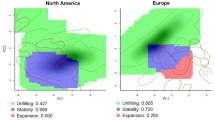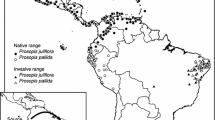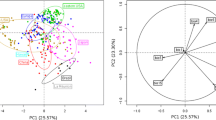Abstract
The historical contingencies of biological invasions may have important consequences for final invasion outcomes. Here, we characterize the variations in the realized niche during the invasions of the bull-headed dung beetle Onthophagus taurus (Coleoptera: Scarabaeidae) from its native Mediterranean range following accidental (Eastern North America) as well as deliberate (Western North America, Western Australia, and Eastern Australia) releases into novel, exotic ranges approximately 50 years ago. Specifically, we examined whether the climatic responses of exotic O. taurus have diverged from those characterizing their native range, and if so, to what degree and in what dimensions. We found that when compared to the native range, all exotic populations exhibited similar overlap proportions regardless of invasion history. However, more detailed analysis of climatic niche features showed that all three deliberately established populations were characterized by overall similar climatic niche features, whereas the accidentally-established Eastern North American populations have undergone significant changes in their climatic niche. Specifically, when analog climates were considered on the background of each pairwise range comparison, accidentally-established Eastern North American populations showed a different climatic niche expansion than their deliberately introduced Australian or Western North American counterparts, in particular towards colder and more humid climates. We discuss our results in the context of the widely divergent introduction histories of O. taurus in Australia and North America, and highlight the possible roles of contrasting propagule sizes, disparate genetic profiles and variances, adaptive processes and invadable landscapes in shaping invasion outcomes in the different exotic ranges.



Similar content being viewed by others
References
Aiello-Lammens ME, Boria RA, Radosavljevic A et al (2015) spThin: an R package for spatial thinning of species occurrence records for use in ecological niche models. Ecography 38:541–545
AMRC (1982) Australian Meat Research Committee. Workshop report. The biological control of dung in Australia. Commonwealth Scientific Research Organization. Canberra
Ancillotto L, Strubbe D, Menchetti M, Mori E (2015) An overlooked invader? Ecological niche, invasion success and range dynamics of the Alexandrine parakeet in the invaded range. Biol Invasions. doi:10.1007/s10530-015-1032-y
Anderson JR, Loomis EC (1998) Exotic dung beetles in pasture and range land ecosystem. Calif Agric 2:21–31
Araújo MB, Pearson RG (2005) Equilibrium of species’ distributions with climate. Ecography 28:693–695
Araújo MB, Peterson AT (2012) Uses and misuses of bioclimatic envelope modeling. Ecology 93:1527–1539
Balthasar V (1964) Monographie der Scarabaeidae und Aphodiidae der palaearktischen und orientalischen region (Coleoptera: Lamellicornia). Band 2, Coprinae. Verlag der tschechoslowakischen Akademie der Wissenschaften, Praga
Barve N, Barve V, Jiménez-Valverde A et al (2011) The crucial role of the accessible area in ecological niche modeling and species distribution modeling. Ecol Modell 222:1810–1819
Bornemissza GF (1976) The Australian dung beetle project, 1965–1975. Aust Meat Res Commitee Rev 30:1–30
Bradley BA, Blumenthal DM, Wilcove DS, Ziska LH (2010) Predicting plant invasions in an era of global change. Trends Ecol Evol 25:310–318
Broennimann O, Fitzpatrick MC, Pearman PB et al (2012) Measuring ecological niche overlap from occurrence and spatial environmental data. Glob Ecol Biogeogr 21:481–497
Broennimann O, Petitpierre B, Randin CF et al (2014) ecospat: spatial ecology miscellaneous methods. R package version 1.0. http://CRAN.R-project.org/package=ecospat
Colwell RK, Rangel TF (2009) Hutchinson’s duality: the once and future niche. Proc Natl Acad Sci USA 106:19651–19658
Courchamp F, Clutton-Brock T, Grenfell B (1999) Inverse density dependence and the Allee effect. Trends Ecol Evol 14:405–410
Da Mata RA, Tidon R, Côrtes LG et al (2010) Invasive and flexible: niche shift in the drosophilid Zaprionus indianus (insecta, diptera). Biol Invasions 12:1231–1241
Davis LV (1958) The Scarabaeidae of Durham and Orange Counties, North Carolina. Duke University, Durham
Deacon AE, Ramnarine IW, Magurran AE (2011) How reproductive ecology contributes to the spread of a globally invasive fish. PLoS One 6:e24416
Doube BM, Macqueen A, Ridsdill-Smith TJ, Weir T (1991) Native and introduced dung beetles in Australia. In: Hanski I, Cambefort Y (eds) Dung beetle ecology, 1st edn. Princeton University Press, Princeton, pp 255–278
Drake JM, Baggenstos P, Lodge DM (2005) Propagule pressure and persistence in experimental populations. Biol Lett 1:480–483
Duncan RP, Cassey P, Blackburn TM (2009) Do climate envelope models transfer? A manipulative test using dung beetle introductions. Proc R Soc B Biol Sci 276:1449–1457. doi:10.1098/rspb.2008.1801
Dymock J (1993) A case for the introduction of additional dung burying beetles (Coleoptera: Scarabaeidae) into New Zealand. New Zeal J Agric Res 36:163–171
Evans AV, Hogue JN (2004) Introduction to California beetles, 1st edn. University of California Press, Berkeley
Faleiro FV, Silva DP, Carvalho RA et al (2015) Ring out the bells, we are being invaded! Niche conservatism in exotic populations of the Yellow Bells, Tecoma stans (bignoniaceae). Nat Conserv 13:24–29
Fincher GT, Woodruff RE (1975) A European dung beetle, Onthophagus taurus schreber, new to the U.S. (Coleoptera: Scarabaeidae). Coleopt Bull 29:349–350
Fitzpatrick MC, Weltzin JF, Sanders NJ, Dunn RR (2007) The biogeography of prediction error: why does the introduced range of the fire ant over-predict its native range? Glob Ecol Biogeogr 16:24–33
Forsman A (2014) Effects of genotypic and phenotypic variation on establishment are important for conservation, invasion, and infection biology. Proc Natl Acad Sci USA 111:302–307
Google Inc. (2015) Google earth, version 7.0.3.8542
Gouveia SF, Hortal J, Tejedo M et al (2014) Climatic niche at physiological and macroecological scales: the thermal tolerance-geographical range interface and niche dimensionality. Glob Ecol Biogeogr 23:446–456
Graham CH, Ferrier S, Huettman F et al (2004) New developments in museum-based informatics and applications in biodiversity analysis. Trends Ecol Evol 19:497–503
Guisan A, Petitpierre B, Broennimann O et al (2014) Unifying niche shift studies: insights from biological invasions. Trends Ecol Evol 29:260–269
Hanski I, Cambefort Y (eds) (1991) Dung beetle ecology, 1st edn. Princeton University Press, Princeton
Higgins SI, Richardson DM (2014) Invasive plants have broader physiological niches. Proc Natl Acad Sci USA 111:10610–10614
Hijmans RJ, Cameron SE, Parra JL et al (2005) Very high resolution interpolated climate surfaces for global land areas. Int J Climatol 25:1965–1978
Hoebeke ER, Beuchke K (1997) Adventive Onthophagus (Coleoptera: Scarabaeidae) in North America: geographic ranges, diagnoses, and new distributional records. Entomol News 108:345–362
Hortal J, Lobo J, Jiménez-Valverde A (2012) Basic questions in biogeography and the (lack of) simplicity of species distributions: putting species distribution models in the right place. Nat Conserv 10:108–118
Jiménez-Valverde A, Lobo JM, Hortal J (2008) Not as good as they seem: the importance of concepts in species distribution modelling. Divers Distrib 14:885–890
Jiménez-Valverde A, Peterson AT, Soberón J et al (2011) Use of niche models in invasive species risk assessments. Biol Invasions 13:2785–2797
Kanarek AR, Webb CT (2010) Allee effects, adaptive evolution, and invasion success. Evol Appl 3:122–135
Kohlmann B (1991) Dung beetles in subtropical North America. In: Hanski I, Cambefort Y (eds) Dung beetle ecology, 1st edn. Princeton University Press, Princeton, pp 116–132
Lenoir J, Svenning J-C (2014) Climate-related range shifts–a global multidimensional synthesis and new research directions. Ecography 37:1–14
Lobo JM, Martín-Piera F (1991) La creación de un banco de datos zoológico sobre los Scarabaeidae (Coleoptera: Scarabaeidae) íbero-baleares: una experiencia piloto. Elytron 5:31–38
Lockwood JL, Cassey P, Blackburn T (2005) The role of propagule pressure in explaining species invasions. Trends Ecol Evol 20:223–228
Martin-Piera F, Lobo JM (1996) A comparative discucion of trophic preferences in dung beetles communities. Misc Zool 19:13–31
Matthews EG (1972) A revision of the scrabaeinae dung beetles of Australia. I. Tribe Onthophagini. Aust J Zool Suppl Ser 9:1–330
McInerny GJ, Etienne RS (2012a) Ditch the niche—is the niche a useful concept in ecology or species distribution modelling? J Biogeogr 39:2096–2102
McInerny GJ, Etienne RS (2012b) Pitch the niche—taking responsibility for the concepts we use in ecology and species distribution modelling. J Biogeogr 39:2112–2118
McInerny GJ, Etienne RS (2012c) Stitch the niche—a practical philosophy and visual schematic for the niche concept. J Biogeogr 39:2103–2111
Moczek AP (2003) The behavioral ecology of threshold evolution in a polyphenic beetle. Behav Ecol 14:841–854
Müller-Schärer H, Steinger T (2004) Predicting evolutionary change in invasive, exotic plants and its consequences for plant–herbivore interactions. In: Ehler L, Sforza R, Mateille T (eds) Genetics, evolution and biological control, 1st edn. CABI Publishing, Wallingford, pp 137–162
Müller-Schärer H, Schaffner U, Steinger T (2004) Evolution in invasive plants: implications for biological control. Trends Ecol Evol 19:417–422
Newbold T (2010) Applications and limitations of museum data for conservation and ecology, with particular attention to species distribution models. Prog Phys Geogr 34:3–22
Pearman PB, Guisan A, Broennimann O, Randin CF (2008) Niche dynamics in space and time. Trends Ecol Evol 23:149–158
Peterson AT (2011) Ecological niche conservatism: a time-structured review of evidence. J Biogeogr 38:817–827
Peterson AT, Soberón J, Pearson RG et al (2011) Ecological niches and geographic distributions, 1st edn. Princeton University Press, Princeton
Petitpierre B, Kueffer C, Broennimann O et al (2012) Climatic niche shifts are rare among terrestrial plant invaders. Science 335:1344–1348
Prentis PJ, Wilson JRU, Dormontt EE et al (2008) Adaptive evolution in invasive species. Trends Plant Sci 13:288–294
Pyke GH, Ehrlich PR (2010) Biological collections and ecological/environmental research: a review, some observations and a look to the future. Biol Rev 85:247–266
R Development Core Team (2015) R: a language and environment for statistical computing. R Foundation for Statistical Computing
Reddy S, Davalos LM (2003) Geographical sampling bias and its implications for conservation priorities in Africa. J Biogeogr 30:1719–1727
Sakai AK, Allendorf FW, Holt JS et al (2001) The population biology of invasive species. Annu Rev Ecol Syst 32:305–332
Sastre P, Lobo JM (2009) Taxonomist survey biases and the unveiling of biodiversity patterns. Biol Conserv 142:462–467
Sax DF, Stachowicz JJ, Brown JH et al (2007) Ecological and evolutionary insights from species invasions. Trends Ecol Evol 22:465–471
Schoener TW (1970) Nonsynchronous spatial overlap of lizards in patchy habitats. Ecology 51:408–418
Simberloff D (2009) The role of propagule pressure in biological invasions. Annu Rev Ecol Evol Syst 40:81–102
Soberón J (2007) Grinnellian and Eltonian niches and geographic distributions of species. Ecol Lett 10:1115–1123
Soberón JM (2010) Niche and area of distribution modeling: a population ecology perspective. Ecography 33:159–167
Soberón J, Nakamura M (2009) Niches and distributional areas: concepts, methods, and assumptions. Proc Natl Acad Sci USA 106:19644–19650
Soberón J, Peterson AT (2005) Interpretation of models of fundamental ecological niches and species’ distributional areas. Biodivers Informatics 2:1–10
Soberón J, Peterson AT (2011) Ecological niche shifts and environmental space anisotropy: a cautionary note. Rev Mex Biodivers 82:1348–1355
Storey RI, Weir TA (1988) New localities and biological notes for the genus Onthophagus Latreille (Coleoptera: Scarabaeidae) in Australia. Aust Entomol Mag 15:17–24
Storey RI, Weir TA (1990) New species of Onthophagus Latreille (Coleoptera: Scarabaeidae) from Australia. Invertebr Taxon 3:783–815
Strubbe D, Matthysen E (2014) Patterns of niche conservatism among non-native birds in Europe are dependent on introduction history and selection of variables. Biol Invasions 16:759–764
Strubbe D, Broennimann O, Chiron F, Matthysen E (2013) Niche conservatism in non-native birds in Europe: niche unfilling rather than niche expansion. Glob Ecol Biogeogr 22:962–970
Strubbe D, Beauchard O, Matthysen E (2015) Niche conservatism among non-native vertebrates in Europe and North America. Ecography 38:321–329. doi:10.1111/ecog.00632
Tingley R, Vallinoto M, Sequeira F, Kearney MR (2014) Realized niche shift during a global biological invasion. Proc Natl Acad Sci USA 111:10233–10238
Tyndale-Biscoe M (1990) Common dung beetles in pastures of south-eastern Australia. CSIRO Press, Canberra
Tyndale-Biscoe M (1996) Australia’s introduced dung beetles: original releases and redistributions. Technical Report No. 62. Canberra, Australia
Warren DL, Glor RE, Turelli M (2008) Environmental niche equivalency versus conservatism: quantitative approaches to niche evolution. Evolution (N Y) 62:2868–2883
Waterhouse DF (1974) The biological control of dung. Sci Am 230:1000–1009
Acknowledgments
We thank two anonymous reviewers for their thoughtful and constructive comments which significantly improved the manuscript, and Kevin Floate, James Ridsdill-Smith, and Jorge M. Lobo for providing us with with occurrence data for O. taurus in its North American, Australian, and native ranges, respectively. D.P.S received a doctorate fellowship from Conselho Nacional de Desenvolvimento Científico e Tecnológico (CNPq) and Coordenação de Aperfeiçoamento de Pessoal de Nível Superior (CAPES). BV received a doctorate fellowship from CAPES. BAB was funded by a Discovery Early Career Researcher Award (DE150101521) from the Australian Research Council. JH was funded by a Spanish DGCyT Ramón y Cajal grant, the CSIC/CNPq Co-operation project 2011BR0071, and the Brazilian CNPq PVE grant 401471/2014-4. Lastly, APM acknowledges support through US National Science Foundation grants IOS 1120209 and 1256689.
Author information
Authors and Affiliations
Corresponding author
Electronic supplementary material
Below is the link to the electronic supplementary material.
Rights and permissions
About this article
Cite this article
Silva, D.P., Vilela, B., Buzatto, B.A. et al. Contextualized niche shifts upon independent invasions by the dung beetle Onthophagus taurus . Biol Invasions 18, 3137–3148 (2016). https://doi.org/10.1007/s10530-016-1204-4
Received:
Accepted:
Published:
Issue Date:
DOI: https://doi.org/10.1007/s10530-016-1204-4




